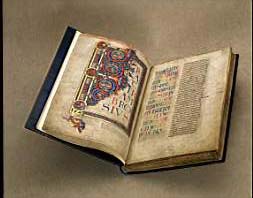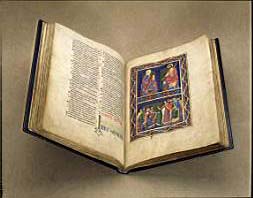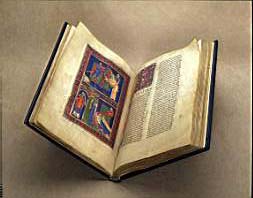What is the Bury Bible?
The Bury Bible is a hand written and illuminated Bible of the type used by the church before the English Reformation. It was originally bound in two great volumes, and is of a great size, compared to books of today. Each page measures 52.5cm by 35 cm and represents just about the largest size page that could be won from a whole calfskin of the time, using a double page per skin. It needed about 350 skins in all.
The written space covers 38 cm by 23.5 cm, in two columns of 42 lines.
What remains today is just the first volume of the great book, ending at the Book of Job. The remaining volume is lost, and is assumed to have been destroyed. What we have has been rebound over the years, and at its last re-binding in 1956, the single volume was made into the three volumes that survive today. There are 357 pages in all still remaining, and example pages and the illuminated pages and initials can be seen on this website in the Bury Bible Picture Gallery.
Many of the decorations were done on separate pieces of parchment, glued to the page before painting.
Six framed miniatures survive from the original twelve in this volume. Forty-two initials in gold and colour survive from an original forty-four.
Clearly it was always valued as a great work, and is often thought of as being for use at the High Altar. However, a 15th century register refers to it as a Refectory Bible, and it may always have been intended for use at meal times to be read from aloud to the monks and novices whilst eating.
The Bury St Edmunds Bible is similar in form and content to other 12th century English bibles such as the Lambeth Bible and the Winchester Bible. However, while the Bury Bible is dated to around 1135 to 1138, the well known Winchester Bible is dated to between 1160 and 1175. The Winchester Bible is fairly complete, and only missing a few pages, whereas the Bury Bible has about half of it missing.
The order and contents of these Bibles is of a type known as a Vulgate Bible, and allowing for several centuries of adjustment, it is still used by the Roman Catholic Church today.
What is a Vulgate Bible?
Following the Norman Conquest, Lanfranc was made the new Archbishop of Canterbury, bringing with him the idea that all English copies of bible texts should be replaced by a common or 'vulgate' version. The approved new and 'true' version would be based upon texts used in places like Lanfranc's old monastery at Bec, in France.
This idea was far from new. Attempts to produce a standard bible had been going on for centuries. The bible itself was known to be a collection of translations of early manuscripts written originally in Hebrew, some of which had been translated into Greek, and then into Latin.
The earliest version of a Vulgate Bible was translated and edited by St Jerome, who lived from c. 341 to 420. In about 382 he was commissioned by Pope Damasus to edit and formalise the New Testament. Fired by this task, he then travelled to Bethlehem in 384 intent upon learning Hebrew and revising all the books of the Old Testament. He became convinced that readers needed some instruction upon each book, and so he wrote a series of Prologues, or Introductions, to each book. These writings were considered to be so important that Jerome's Prologues were included in most , if not all, Vulgate Bibles produced in monastic houses after the 9th century.
In addition to his Prologues, St Jerome had considerable correspondence with other Bible Scholars of his age, including Paulinus of Nola.
While he was working in Bethlehem, a pilgrim called Frater Ambrosius, arrived there with a letter from Paulinus.
Jerome wrote back to Paulinus from Bethlehem describing these scriptures, and the significance of the various Books that follow. He warned Paulinus that the Bible was full of great mysteries and should not be read without guidance. This letter was later considered so important that it was routinely copied into the opening pages of Vulgate Bibles from the 9th to the 12th centuries. Today this letter is catalogued as Letter 53 of Paulinus.
A summary of this letter comes from the website www.newadvent.org as follows:
"Jerome urges Paulinus, bishop of Nola, to make a diligent study of the Scriptures and to this end reminds him of the zeal for learning displayed not only by the wisest of the pagans but also by the apostle Paul. Then going through the two Testaments in detail he describes the contents of the several books and the lessons which may be learned from them. He concludes with an appeal to Paulinus to divest himself wholly of his earthly wealth and to devote himself altogether to God. Written in 394 A.D. "
Thus, in the Bury Bible, the opening page includes the note that here begins the words of St Jerome's letter that was addressed to St Paulinus of Nola. The Bury Bible's opening script clearly begins "Frater Ambrosius....." These first few words may be translated as follows, and are taken from the same website:
"Our brother Ambrose along with your little gifts has delivered to me a most charming letter which, though it comes at the beginning of our friendship, gives assurance of tried fidelity and of long continued attachment......"





